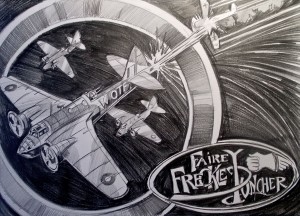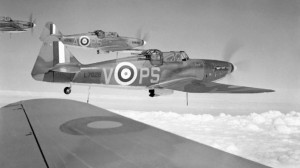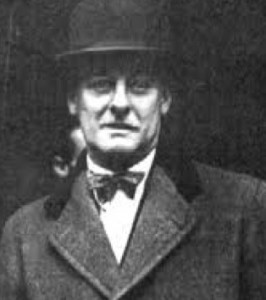In the heady early days of the Second World War, the outnumbered RAF was forced to play a deadly cat and mouse game with the mighty Luftwaffe. On several disastrous raids on Wilhelmshaven and Hamburg, No’s 107, 110 and 139 squadrons incurred terrible losses as the Blenheim’s and Hampdens were unable to match the sheer firepower of the deadly Messerschmitt 109’s and Junkers 88’s. Embarrassingly after the fall of Dunkirk, the well equipped Boulton Paul Defiant, though formidable in its quadruple Vickers mounted power operated turret soon proved easy game for the german fighters who followed. They possessed the simple expedient of flying beneath the vulnerable underside and plugging the airframe with cannon shell.
‘Clearly the issue was a peculiarly defensive one’ as described by Arthur ‘Bomber’ Harris ‘We had to counter their delight in getting up our rear’.
It soon became quite clear, the Hampden’s also lacked defensive punch and were near naked. Similarly the Blenheim, was outgunned and no defence could be offered to the speed and agility of the persistent german probing.
The Fairey Aircraft Company took up the challenge and began the process of augmenting the rear defense and upgrade the existing bomber squadrons until such time as the heavies, the Short Stirling, the Lancaster and Halifax were ready for action. Faced with the daunting task the Chief Designer, Flt Lieutenant, Harvey Freckle RAAF, came up with an ingenious solution. He devised a system in which a Blenheim could be adapted. Hidden within the fuselage a specially adapted quadruple 20 mm Hotchkiss gun would fire along the length of the fuselage, and deliver real punch to any unsuspecting hun who was determined to gain advantage. Camoflague was added to make the English tail more attractive for a would be aggressor. Extensive alterations were made to the Blenheim’s with Fairey Fulmar engines, Firefly ailerons and Albacore dive breaks. Reconfigured as both ground attack and dive bomber they were capable of deep penetration. The Blenheim’s were renamed in honour of the inventor and ceremonially named at their unveiling by none other than the aged Lord Alfred Douglas, and thus aptly named, Fairey Frecklepuncher. ‘A Fairey with More Punch, and in reference to the armament, more penetration’.
Prototypes were tested and proved deadly accurate when a squadron of Bloch’s en route to England after Dunkirk were dispatched to follow a Blenheim squadron home. Without radio communication and charts the French directed their formation right into the English rear. Gaining on their allies the Bloch’s took up loose formation behind the English and prepared to move in closer to ensure better protection with their combined defensive armament. However the french discovered the back passage blocked. After the six week campaign the english had the wind up them and were trigger happy. The British aircrews mistook them for Ju 88’s. Activating the 20 mm Gatling the Blenheim crews systematically blasted them from the sky. The subsequent enquiry, revealed, “ we had no idea they were Froggies, or we’d’ve let em in, but fearing the hun were making an agressive push on our unprotected behind, we let em have it”.
Only one pilot, Monsieur Hulot of the 15th Couchon squadron survived. His testament was abrupt, ‘I had no desire to join you feelthy english in the first place, as you made such easy meat by grinding my companions’. There was bad blood between the french and english thereafter.
Thus, equipped a squadron of Hampden’s was fitted with the device and made plans for a attack on the U-boat pens at Kiel. As predicted they were intercepted en route, and closed formation tempting any of the hun to have a go. Unbeknown to the English, the germans did not intercept the squadron with Messerschmitts or Junkers but decided to blood their new squadron of Focke’s’ with the deadly Focke Wulf 190. The melee was intense as aircraft circled and parried, the English formation losing valuable height and advantage in the process. Unable to match the Focke’s for speed and agility they packed into a tighter formation still, and one by one succumbed to the firepower of the agile fighter. There was only one survivor. (Flt Sergeant Les Dickles, RAAF) The squadron history described the encounter thus; ‘Unable to outrun or outgun, the hum rammed home his advantage until he had us face to the ground, and lunged breaking our rear defense and making easy play of our tail gunners. If we’d attacked at height and in loose formation we might have gained advantage of the Focke. But without initiative and the element of surprise, we were doomed’. A subsequent enquiry revealed that the Luftwaffe already knew of the up gunned Fairey Freckle-puncher and devised a method of attack whereby the Focke just moved up behind the airstream and let play with the tail. Once stability was lost, the Frecklepuncher could neither fight nor flail. ‘The Focke got into our rear and we were buggerred’. (Les Dickles) ‘It was a lazy Focke who couldn’t lick the tail end’.

Science and Industry Minister Pyne demonstrates close encounter with a Frecklepuncher in Parliament.
No Frecklepuncher’s survive, but it is alleged that one experimental airframe is being considered as a replacement for the joint strike fighter. And incredibly the crew have been equipped with a new non freckle-punching bullet proof uniform, designed impressively in Latex and self sealing rubber by the former Minister for Education Christopher Morris Pyne. The aircraft is to be upgraded with modern avionics and be re-christened with additional stealth capacity as the Furtive Freckle-Fixer. In honour of the Minister and the unheralded inventor, Lieut Cmdr, Harvey Freckle.
Happily, the Freckle legend lives on.



